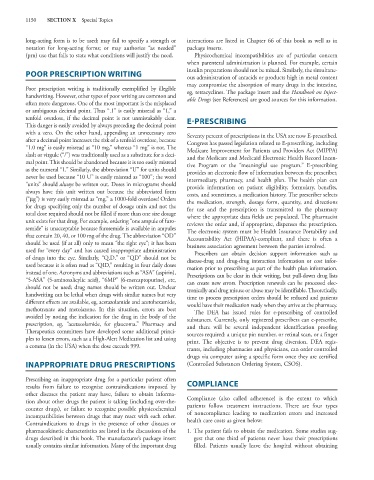Page 1164 - Basic _ Clinical Pharmacology ( PDFDrive )
P. 1164
1150 SECTION X Special Topics
long-acting form is to be used; may fail to specify a strength or interactions are listed in Chapter 66 of this book as well as in
notation for long-acting forms; or may authorize “as needed” package inserts.
(prn) use that fails to state what conditions will justify the need. Physicochemical incompatibilities are of particular concern
when parenteral administration is planned. For example, certain
POOR PRESCRIPTION WRITING insulin preparations should not be mixed. Similarly, the simultane-
ous administration of antacids or products high in metal content
may compromise the absorption of many drugs in the intestine,
Poor prescription writing is traditionally exemplified by illegible eg, tetracyclines. The package insert and the Handbook on Inject-
handwriting. However, other types of poor writing are common and able Drugs (see References) are good sources for this information.
often more dangerous. One of the most important is the misplaced
or ambiguous decimal point. Thus “.1” is easily misread as “1,” a
tenfold overdose, if the decimal point is not unmistakably clear. E-PRESCRIBING
This danger is easily avoided by always preceding the decimal point
with a zero. On the other hand, appending an unnecessary zero Seventy percent of prescriptions in the USA are now E-prescribed.
after a decimal point increases the risk of a tenfold overdose, because Congress has passed legislation related to E-prescribing, including
“1.0 mg” is easily misread as “10 mg,” whereas “1 mg” is not. The Medicare Improvement for Patients and Providers Act (MIPPA)
slash or virgule (“/”) was traditionally used as a substitute for a deci- and the Medicare and Medicaid Electronic Health Record Incen-
mal point. This should be abandoned because it is too easily misread tive Program or the “meaningful use program.” E-prescribing
as the numeral “1.” Similarly, the abbreviation “U” for units should provides an electronic flow of information between the prescriber,
never be used because “10 U” is easily misread as “100”; the word intermediary, pharmacy, and health plan. The health plan can
“units” should always be written out. Doses in micrograms should provide information on patient eligibility, formulary, benefits,
always have this unit written out because the abbreviated form costs, and sometimes, a medication history. The prescriber selects
(“μg”) is very easily misread as “mg,” a 1000-fold overdose! Orders the medication, strength, dosage form, quantity, and directions
for drugs specifying only the number of dosage units and not the for use and the prescription is transmitted to the pharmacy
total dose required should not be filled if more than one size dosage where the appropriate data fields are populated. The pharmacist
unit exists for that drug. For example, ordering “one ampule of furo- reviews the order and, if appropriate, dispenses the prescription.
semide” is unacceptable because furosemide is available in ampules The electronic system must be Health Insurance Portability and
that contain 20, 40, or 100 mg of the drug. The abbreviation “OD” Accountability Act (HIPAA)-compliant, and there is often a
should be used (if at all) only to mean “the right eye”; it has been business association agreement between the parties involved.
used for “every day” and has caused inappropriate administration Prescribers can obtain decision support information such as
of drugs into the eye. Similarly, “Q.D.” or “QD” should not be disease-drug and drug-drug interaction information or cost infor-
used because it is often read as “QID,” resulting in four daily doses mation prior to prescribing as part of the health plan information.
instead of one. Acronyms and abbreviations such as “ASA” (aspirin), Prescriptions can be clear in their writing, but pull-down drug lists
“5-ASA” (5-aminosalicylic acid), “6MP” (6-mercaptopurine), etc, can create new errors. Prescription renewals can be processed elec-
should not be used; drug names should be written out. Unclear tronically and drug misuse or abuse may be identifiable. Theoretically,
handwriting can be lethal when drugs with similar names but very time to process prescription orders should be reduced and patients
different effects are available, eg, acetazolamide and acetohexamide, would have their medication ready when they arrive at the pharmacy.
methotrexate and metolazone. In this situation, errors are best The DEA has issued rules for e-prescribing of controlled
avoided by noting the indication for the drug in the body of the substances. Currently, only registered prescribers can e-prescribe,
prescription, eg, “acetazolamide, for glaucoma.” Pharmacy and and there will be several independent identification proofing
Therapeutics committees have developed some additional princi- sources required: a unique pin number, or retinal scan, or a finger
ples to lessen errors, such as a High-Alert Medication list and using print. The objective is to prevent drug diversion. DEA regis-
a comma (in the USA) when the dose exceeds 999. trants, including pharmacies and physicians, can order controlled
drugs via computer using a specific form once they are certified
INAPPROPRIATE DRUG PRESCRIPTIONS (Controlled Substances Ordering System, CSOS).
Prescribing an inappropriate drug for a particular patient often
results from failure to recognize contraindications imposed by COMPLIANCE
other diseases the patient may have, failure to obtain informa-
tion about other drugs the patient is taking (including over-the- Compliance (also called adherence) is the extent to which
counter drugs), or failure to recognize possible physicochemical patients follow treatment instructions. There are four types
incompatibilities between drugs that may react with each other. of noncompliance leading to medication errors and increased
Contraindications to drugs in the presence of other diseases or health care costs as given below:
pharmacokinetic characteristics are listed in the discussions of the 1. The patient fails to obtain the medication. Some studies sug-
drugs described in this book. The manufacturer’s package insert gest that one third of patients never have their prescriptions
usually contains similar information. Many of the important drug filled. Patients usually leave the hospital without obtaining

